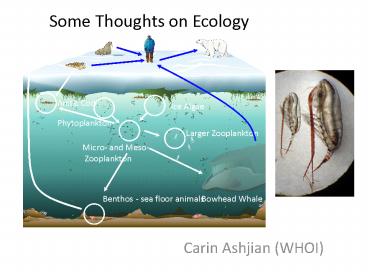Some Thoughts on Ecology - PowerPoint PPT Presentation
1 / 12
Title:
Some Thoughts on Ecology
Description:
Carin Ashjian (WHOI) Arctic Cod Ice Algae Phytoplankton Larger Zooplankton Micro- and Meso-Zooplankton Benthos - sea floor animals Bowhead Whale Some Thoughts on Ecology – PowerPoint PPT presentation
Number of Views:149
Avg rating:3.0/5.0
Title: Some Thoughts on Ecology
1
Some Thoughts on Ecology
- Carin Ashjian (WHOI)
2
Arctic Food Web
Jayne Doucette, WHOI
3
(No Transcript)
4
How will the ecosystem respond to the conditions
of the new Arctic? Quantify biological and
chemical distributions, stocks, transformations
- How will changing ocean conditions (warmer
temperatures) impact critical ecosystem
processes? - Life histories of the dominant plankton
(phytoplankton, zooplankton, microzooplankton) - Timing of primary and secondary production and
linkages of the phenologies - Production/Growth rates of different components
of the ecosystem - What is the timing and mechanism of nutrient
regeneration? - What is the duration and magnitude of primary
production under the sea ice and what limits it
(light or nutrients)? - Will the changing sea ice conditions result in
increased primary production that will cascade
upwards through the ecosystem?
5
Ecology during and at spatial/temporal transitions
- How does the ecosystem shut down / ramp up during
the fall-winter and winter-spring transitions? - When does epontic and pelagic primary production
commence and how does it evolve? What is the
importance of melt ponds and leads to the timing
of this primary production? - How patchy is ice algae? How does ice algae
cover impact albedo and the penetration of light
into the water column? - What is the importance of the epontic algal
community to pelagic grazers? How do the grazers
impact the distribution of ice algae? - How does spatial heterogeneity in the physical
environment (e.g., ice cover, fronts, vertical
structure) impact biological distributions and
processes and produce patchiness in those
characteristics?
6
How does this relate to the system?
- Carbon flux Consumption and production of carbon
- Ocean Optics
- Production of aerosols
- Changes in albedo and ice melt associated with
ice algae
7
Other Issues
- Ocean acidification temporal and spatial
variability (?) - How can we improve our parameterization of
ecosystem models? (do we need to?) - Benthos in the basin it seems far removed from
the pelagic system and the sea ice. Important on
shelves
8
Old tools and new tools
- Nets
- Niskin bottles
- Optical instruments
- Acoustic instruments
- Sensors pH, O2, light, fluorescence, nutrients,
transmissivity, etc. - Vehicles and platforms ROVs and AUVs for
sub-ice surveys and sampling, ITPs - Modeling ecosystem and individual based
9
Biogeography Individual based model
C. finmarchicus/marshallae
C. glacialis
Blue dots release locations Red dots end
locations
R. Ji et al. 2011
C. hyperboreus
- Locations where Calanus species successfully
reach diapause under temperature and food
dependent development for C. finmarchicus/marshall
ae and temperature dependence alone for C.
glacialis and C. hyperboreus in the first year of
development
10
(No Transcript)
11
Ecosystem studies during winter, including
chemical transformations
- What is the ecosystem doing during winter?
- Which species are dormant? And which are active?
- What are the overwintering mechanisms of the
different organisms and trophic levels?
12
Long-Term Biological Process Studies
- The establishment of a stable platform (ship)
with on-board laboratory facilities will permit
long-term (weeks-months) biological process
studies. Because of the cold temperatures, many
zooplankton and fish grow at slower rates than in
lower, warmer latitudes. Because of this,
quantification of growth and development rates is
difficult, particularly in a controlled
environment































